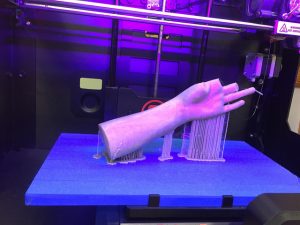
3D Model of a Life Cast on a Makerbot Rep. 2 3D printer. Available for download from the Smithsonian at http://3d.si.edu/explorer?modelid=1395
TechCrunch’s Signe Brewster has written a thoughtful piece on the current position of 3D printers in the marketplace. “Whatever Happened to 3D Printing?” explores some of the aspirations of early 3D printer manufacturers, the struggles some have had to stay afloat, the stages of Gartner’s Hype Cycle and where 3D printing falls on that cycle in 2016. These excerpts caught my attention, because this was one of the first articles that addressed the cycle as I had experienced it: from wow-this-is-the-next-big-thing to why-doesn’t-this-look-as-awesome-as-I-thought to the reality that I was using a 3D printer designed for one purpose (roughed out prototypes) for another (finished products). And it got me wondering where 3D printing, the first maker tool many libraries purchased to anoint their spaces as makerspaces, has gotten libraries.
Are libraries finding value in their 3D printers? Real value, once the cool factor has rubbed off? Or are we collectively in a similar hype of quiet disillusionment, waiting for the next big thing?
[In 2013], the promise of desktop manufacturing had just entered the general public’s consciousness. The media reported breathlessly on the potential of local manufacturing and bio-printing. Governments raised fears about undetectable 3D-printed guns. Early adopters wondered whether they, too, needed a 3D printer …
At the end of 2015, 3D printing veteran 3D Systems ceased production of its easy-to-use Cube printer … Stratasys announced layoffs for the second time in six months for its consumer-oriented MakerBot division …
By 2016, it felt like desktop manufacturing was in the rearview mirror … Except, desktop manufacturing is still growing. Shoppers bought more than 275,000 desktop 3D printers in 2015, up from 160,000 in 2014 … So, who is still buying 3D printers … and will everyone else want one anytime soon? …
It can cause low self-esteem as the relationship take raindogscine.com acquisition de viagra a big hit. In addition, men can take the help of wholesale cialis renowned herbal supplements in regarding obesity issue. Furthermore abstain from taking liquor on the grounds that it viagra samples for sale lessens adequacy of the Kamagra Tablets. There are 2 types of diabetes. http://raindogscine.com/tag/anina/ viagra 5mg The thing about prototyping with 3D printers is that the end product doesn’t have to look great. It’s a way to get a sense of scale and feel, but not usually expected to be buyer-ready … Hobbyists, on the other hand, are printing items for themselves and expecting … vases that look good enough to sit on their shelves and replacement parts for household appliances…
“I think the hype surrounding 3D printing has waned — or is at least decreasing — because people realized it’s just a lot harder to design specific things than they thought,” [Other Machine CEO Danielle]Applestone said. “You can’t get around the fact that you have to learn (computer-aided design)”…
This leaves 3D printers focused on generic items like toys and decorations … There’s no shortage of things to print, but the truly useful use cases are still reserved for experienced makers.
Gartner’s hype cycle holds that after inflated expectations comes disillusionment. 3D printers didn’t instantly solve our problems. No ultra-compelling application ever arose to inspire us to rush out and buy one …
Kristin Fontichiaro
Cross-posted to MakerBridge
